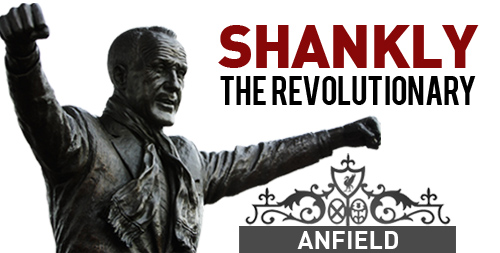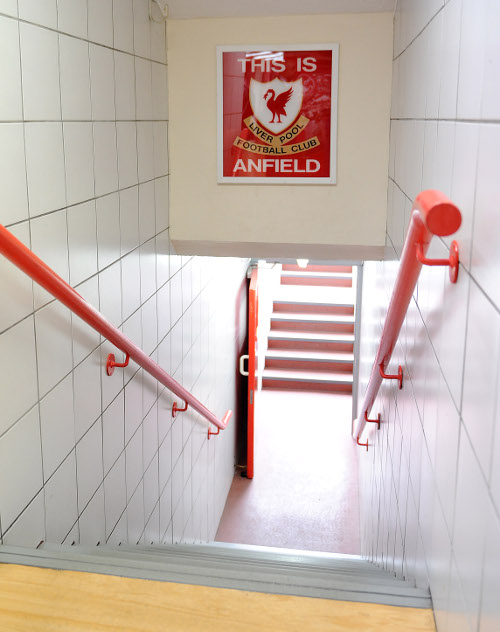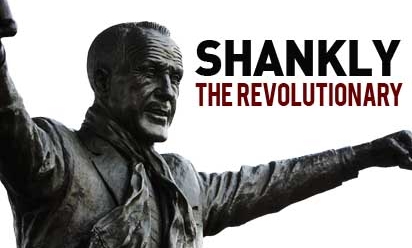How Bill Shankly changed Anfield
To mark the 100th anniversary of the birth of the great Bill Shankly, we've taken a look at the different areas of the club he revolutionised during his 15 years at the helm – and today we focus on Anfield.

Brendan Rodgers ducks out of the home team dressing room and into the tunnel and all eyes immediately fall on him.
Cameras are hoisted obediently onto shoulders as the din descends and presenters straighten their ties, clear their throats and grip microphones at the ready.
Rodgers is steered through the crowds to a small cubby-hole plastered with shiny sponsors, where spotlights nailed to the roof are trained on his face and force him to blink.
Somewhere above the boss, Liverpool fans are filing out of the main stand, while on the other side of a labyrinth of corridors and staircases, guests are being served pints of lager and glasses of wine at tables laid for 10.
Through another set of double-doors and up a flight of stairs, journalists sit hunched over laptops rattling away on keyboards as the final songs boom out over the tannoy and the pristine Anfield turf is tidied by ground staff.
Back in the tunnel, Daniel Sturridge is guided through the crowds to a camera as current and ex-players mingle and people call out to each other across the whole scene.
It's a completely modern-day scenario, and the setting is suitably polished and cutting-edge, with rubber floors to withstand the rattle of studs, and iconic images stencilled onto the walls.
But overlooking the whole picture is a constant reminder of the club's past - a sign which hangs proudly above the entrance to the pitch, which seems almost serene as the backdrop to the bustle that surrounds it.

Bill Shankly put it there towards the end of his time as Liverpool manager, a parting gift that would act as the final touch to a career's worth of work that completely revolutionised Anfield.
"We were strong on psychology - we even had a plaque that was put over the tunnel that takes the players from the dressing rooms to the pitch," said Shankly.
"Our maintenance foreman, Bert Johnson, had it painted, with letters on a red background: This is Anfield. It was a form of intimidation."
When Shankly arrived at Anfield in December 1959, he found the stadium in pretty much the same state as the club's training ground, Melwood - it was falling to pieces.
The place was an eyesore and when Shankly asked the groundsman about his watering equipment, the reply came: "We don't have equipment, because there is no water."
So one of the first things the Scot put in place was to shell out the £3,000 that would install adequate watering facilities, but he knew the ground was neither big enough nor good enough for the public of Liverpool.
Stephen Done, Liverpool FC's museum curator, explained: "Anfield was in a very bad way. Shankly even called the place a pigsty and he was quite clear: he thought the place was shocking. So he immediately started the first proper rebuilding process since 1906.
"Post 1906, a roof had been put on the Kop in 1927, but that was it. Nothing else had happened apart from the floodlights being put in place in 1957.
"The designs that were set in place in 1906 basically laid the foundations for the Kop and the new stadium. So you can imagine it was probably looking a bit dated and decrepit."
The Kemlyn Road stand, which is now called the Centenary Stand, was demolished after Shankly's side won promotion to the top flight at the end of the 1961-62 season.

At costs of £350,000 a massive new cantilever stand (above) was built in its place, which retained the name of its predecessor.
The next change was to pull down the stand on Anfield Road and construct a brick terrace to replace it - work on this began following the 1964-65 campaign.
Shankly chose to expand the main stand, rather than demolish it - and the Scot made sure his input was heard as decisions were being made during construction.
"There were drawings of all sorts of variations on the main stand, and Shankly was trying to think of the facilities he would need there," said Done. "The famous Boot Room as we now know it was there.
"Shankly got rid of the gymnasium - that went up to Melwood and by the time Bob Paisley took over, he'd presented Bob a cracking stadium for his time."
Work on the main stand was concluded in March 1973, which included seats, better facilities for the players and also the inclusion of a proper TV gantry.
A year later, Shankly was to shock the footballing world by delivering his resignation, but he had renovated Anfield to the extent that his successor, Paisley, had a world-class ground in place.
"Shankly didn't touch the Kop," said Done. "He knew it was excellent for its purpose. So otherwise, what Shankly set in place served Liverpool up until Lord Justice Taylor's report in 1994.
"He was the instigator of all that work - he demanded that it was done. You can imagine the boardroom battles Shankly undertook to get them to try and spend that money.
"He came up against the old guard of conservative directors, who thought - why spend? It's worked fine all these years; the Anfield Road end has been here since time immemorial. So why should we spend any money on it?
"Shankly's attitude was to give the fans somewhere fit for purpose. Give them somewhere better. If he hadn't have arrived, it makes you wonder quite what state Anfield would have got into."



